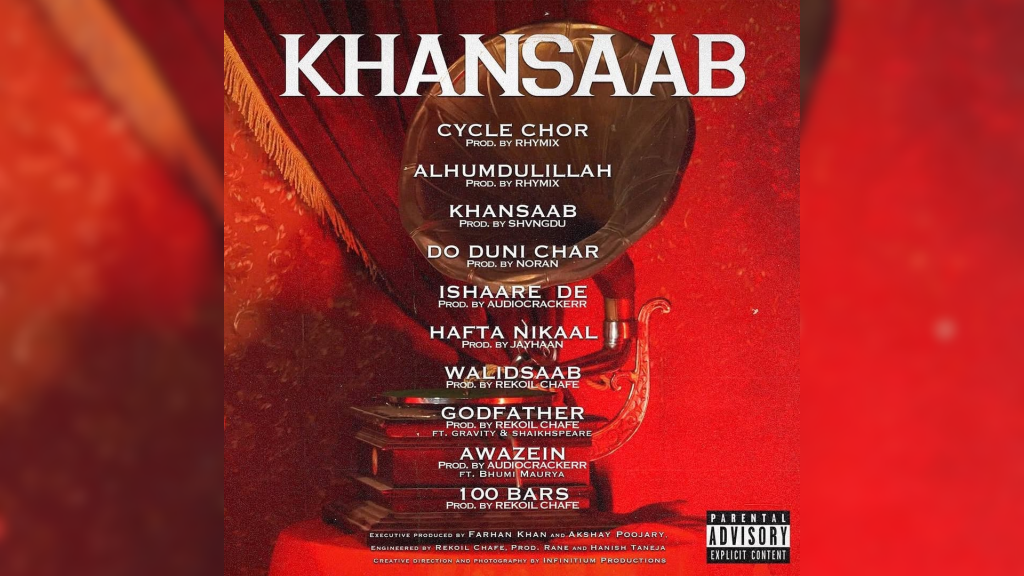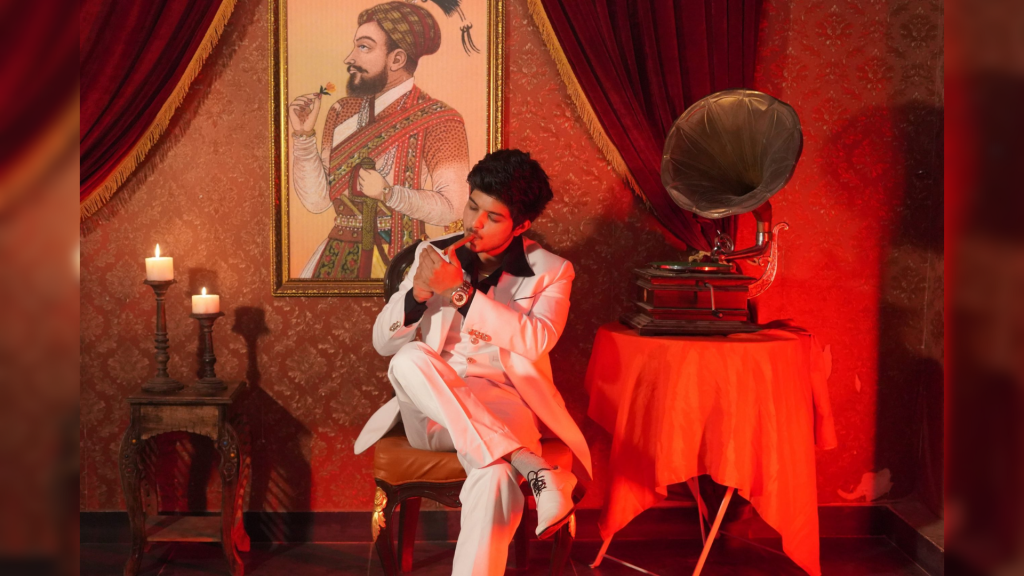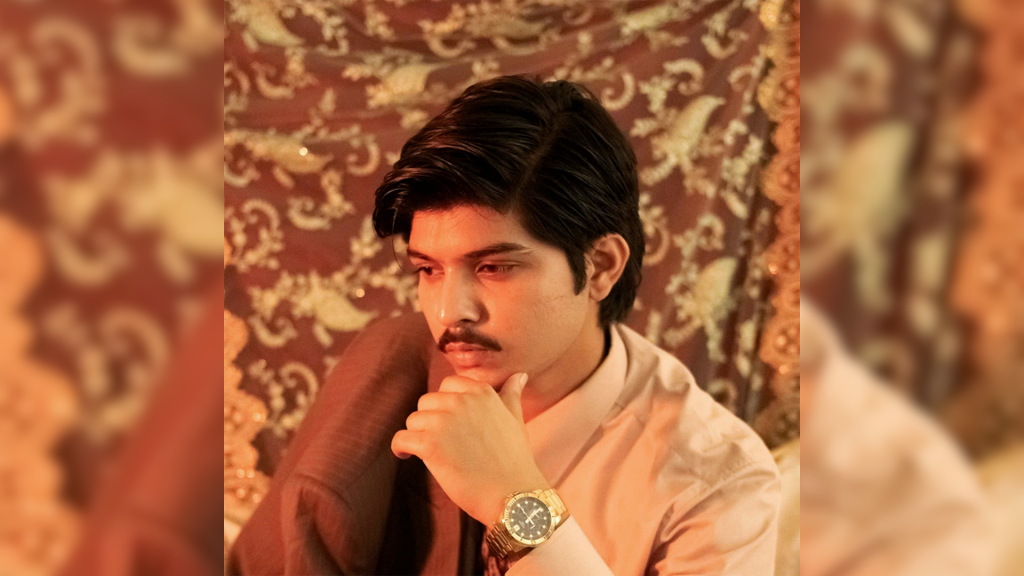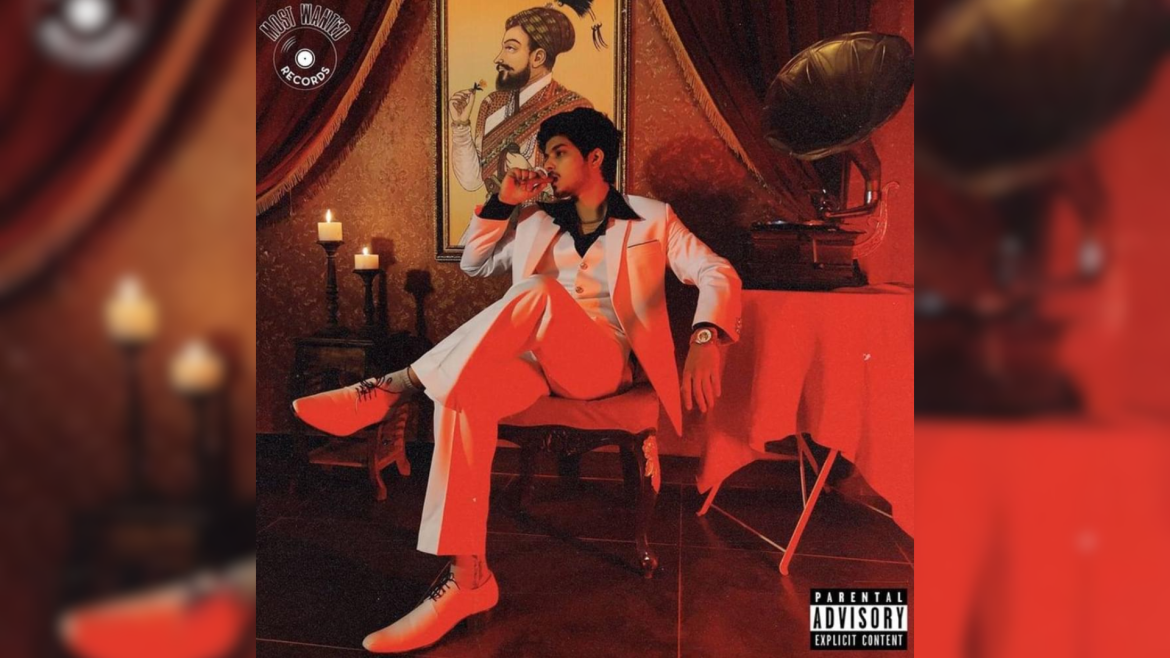In November 2021, Farhan Khan released his debut album “KHANSAAB,” more than just a collection of tracks; it was Farhan Khan’s statement of arrival. A fusion of retro aesthetics inspired by Mumbai’s street-gang era and poetic storytelling, layered over a retro-contemporary sound. The result is a cinematic soundscape that feels both deeply nostalgic and modern at the same time.
Khan emerged as one of the rare artists to seamlessly bridge classical Urdu poetry with modern hip-hop sensibilities, carving a unique niche in the Indian hip-hop scene. With punchlines that still resonate years later, we revisit the album that introduced an artist who would go on to deliver mass poetic hits like “Cigarette”, cementing his place as one of the finest voices in hip-hop and poetic fusion.
KHANSAAB: A Cinematic Masterpiece By Farhan Khan

At just 26 minutes, KHANSAAB may seem like a short album; yet, it packs depth across its 10 tracks, comprising 2 skits and 8 songs. The project also features Gravity, Shaikhspeare, Bhumi Maurya, and 1FlowCrew, each adding their distinct quality to the album.
With a unique ability to mix poetry and storytelling in rap, Khan gave some of the album’s most iconic bars.
Establishing Identity and Origin

The opening track “Cycle Chor” serves as Khan’s autobiography :
“Aur aaj bhi wahi hu bahu shakal
Wahi masoom chehra aur paagal zehen hai
Wahi bhaad daud bhari zindagi Wahi maar peet
Kabhi haath aur kabhi pen se ” ~ Cycle Chor
These lines from the opening skit establish that, despite coming from a poor and notorious neighborhood, Khan was an innocent man who later resorted to violence for survival. This psychological duality of Khan is carried and can be seen throughout his music.
“Jo bachpan ke sapno ki hoti shakal to phir lag jaate lashon ke dherr
Sapne daba ke hum kafi chale par na rakhte daba ke hum pair ” ~ Alhamdulillah
These bars detail the established storyline of a troubled childhood, but rather than glorifying poverty, he explores how suppressed dreams create internal conflict that becomes his fuel.
Mumbai Underworld
Khan’s cinematic references create a neo-noir atmosphere throughout the album:
” Khel ka Haji Mastaan dekhne pe lele jaan
Nazre mili humse tho fir sar jhuka ke mafi mang ” ~ Khansaab
” Sabko nachaataa khel ka bana mai madari
Na pasand hai gaddari mai sanki cornal gaddafi “ ~ 100 Bars
” Maya dollas lokhandwala ganpat saale table poch ” ~ 100 Bars
These aren’t mere name-drops; they’re cultural shorthand connecting Khan’s personal narrative to the street folklore. These references create imagery of a power hierarchy and position Khan within that structure.
The Godfather
The track “Godfather” exemplifies Khan’s character-driven storytelling :
” Baap vito beta Michel
Ye Godfather title ” ~ Godfather
” Napasand hai choohe, parivaar mai na Fredo “ ~ Godfather
” “Game” ka mai OG jaise Nintendo
Godfather shit, dete shot jaise Brando “ ~ Godfather
Inspired by The Godfather, the track Godfather does justice to its name with layered references to Don Corleone’s aura, Michael’s rise, and the rejection of Fredo for disloyalty. Khan ties these classics with his own narrative, blending mafia iconography with hip-hop storytelling.
Romantic Poetry & Street Life
“Ishaare De” showcases Khan’s ghazal-influenced romantic writing :
” Chune de sanson se lehrati zulfein jo
Chehre pe ungli se kaano ke piche le jane de ” ~ Ishaare De
” Bolun mai jab bhi ankhon ke aage tu har din pehle ho
Fir ho subha mere kal ki ” ~ Ishaare De
The ability to maintain authentic Urdu literary tradition while adapting it to rap’s rhythmic demands showcases his bridge-building between classical poetry and contemporary rap.
“Hafta Nikaal” stands out as the album’s energetic storytelling track, blending with catchy delivery. Khan turns street life into art through wit and wordplay, proving that social commentary can be both authentic and entertaining without being heavy-handed. Farhan goes bar for bar with a witty and wicked sense of humour, packed with electrifying flows and an unmatched bounce.
Voices in the Head
“Awazein” stands as the album’s most psychologically intimate track, exploring the universal human experience of internal conflict. The title itself refers to “voices”, immediately establishing the song’s central metaphor of the internal voices of humans that pull every individual in opposing directions.
“ Ek behna sang chahta hai lehro ke
Duja band betha hai khudme hi kaid hoke
Ek ko hai udna hawao mai
Duje ko niche hai rehna dafan hoke ” ~ Awaazein
Khan validates the complexity of human psychology, acknowledging that uncertainty and internal conflict are not weaknesses but inevitable parts of the human experience. This empathetic approach elevates the song from personal confession to universal commentary.
Closing Act
The closing bars of “100 Bars” serve as Khan’s artistic statement :
” Beat karta ride mera World jese astro
Asli Hip-Hop karta spit fire facts bro
Only power moves kardun band sabka techno ” ~ 100 Bars
True to its name, the song delivers 100 raw bars of pure hip-hop, hard-hitting, uncompromising, and unapologetically authentic. It not only sums up the album’s essence but also cements the closing act as a powerful declaration of Khan’s style and vision. The technicalities of breath control, intricate rhyme schemes, and sustained creativity showcase the true strength of Khan as a rapper.
Conclusion: Why KHANSAAB Is More Than Just Your Average DHH Album

KHANSAAB is more than a debut. Across just 26 minutes, Farhan Khan establishes himself as an artist capable of bridging classical Urdu poetry with the grit of street narratives, turning retro aesthetics into a sound that feels timeless yet modern. From the autobiographical opening act of Cycle Chor to the mafia-laced storytelling of The Godfather, the psychological depth of Awazein, and the raw technical showcase of 100 Bars, the album demonstrates both artistic range and lyrical fearlessness.
Nearly four years later, the album still sounds fresh and still hits. The legacy of the album paved the way for Khan in the industry.
Hip Hop influenced me at an early age, so here I am returning the favor. ~Yash Kumar Singh


Leave a Reply